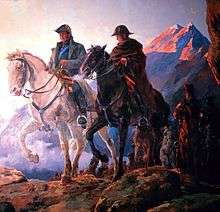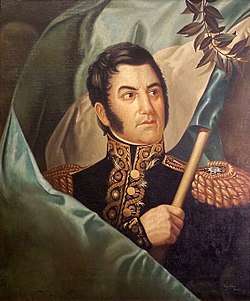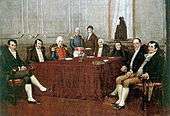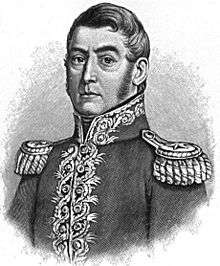Crossing of the Andes
The Crossing of the Andes (Spanish: Cruce de los Andes) was one of the most important feats in the Argentine and Chilean wars of independence, in which a combined army of Argentine soldiers and Chilean exiles invaded Chile leading to Chile's liberation from Spanish rule. The crossing of the Andes was a major step in the strategy devised by José de San Martín to defeat the royalist forces at their stronghold of Lima, Viceroyalty of Perú, and secure the Spanish American independence movements.
| Crossing of the Andes | |||||||
|---|---|---|---|---|---|---|---|
| Part of the Spanish American wars of independence | |||||||
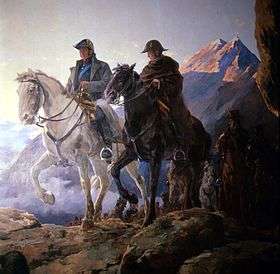 Generals José de San Martín (left) and Bernardo O'Higgins (right) crossing the Andes. | |||||||
| |||||||
| Belligerents | |||||||
|
|
| ||||||
| Commanders and leaders | |||||||
|
|
| ||||||
Setting out from Mendoza -then part of the Province of Cuyo- in January 1817, their goal was to enter royalist-held Chile without being noticed, through unexpected paths, so as to attack the royalist forces by surprise. The ultimate objective was the liberation of Chile from Spanish rule with Argentine forces. Led by José de San Martín, the crossing took 21 days.
Background
The idea of crossing the Andes was already developed by secret lodges seeking the independence of South America, and was part of the Maitland Plan designed by Thomas Maitland. San Martín learned of it during his brief time in Britain, before sailing to South America. After becoming aware of the difficulty of attacking the royalist stronghold of Lima across Upper Peru, he decided to proceed with such a plan.
The Captaincy General of Chile had removed their governor in 1810, and replaced him with the First Government Junta, starting a period of Chilean history known as Patria Vieja. However, they would be defeated in 1814 during the battle of Rancagua, and with the Reconquista Chile would become again a royalist stronghold. Bernardo O'Higgins and other Chilean leaders had fled to Mendoza during the new royalist government, which led to O'Higgins being part of the Army of the Andes as well as the Argentine soldiers.
Troops and equipment
The city of Mendoza, during this time frame, became a factoring headquarters during the pre-crossing. The citizens of Mendoza assisted their troops by manufacturing gunpowder and ammunition. They also learned to make cannons.
The main food of the army was a regional meal called valdiviano. It was prepared with dry meat or charqui, sliced raw onion, and boiling water. They had designated soldiers who carried the food. These soldiers transported forty tons of charqui; maize cakes; meat; brandy, to counter the nighttime cold; garlic and onion, to deal with the lack of appetite; more than 4,000 cattle for the rest of the campaign; plus cheese and rum.[1]
Crossing
On the morning of January 19, 1817, San Martin and his army set out from their base camp El Plumerillo and began their journey across the Andes Mountain range. San Martin crossed with 4,000 men, only to end up losing 1/3 of them. It was a devastating blow to the troop. The number of auxiliaries reached 1,200.
For the crossing, San Martin split his army into two divisions: The main division, which traveled through the pass of Los Patos, was led by San Martin, Miguel Estanislao Soler and Bernardo O'Higgins. The secondary troop, which traveled through the more southern Uspallata, was led by Juan Gregorio de Las Heras.[1]
Coming to an end
On February 13, 1817, San Martín, O’Higgins, and their army successfully entered Santiago, Chile, after crossing 500 kilometers of mountain range, and the journey came to an end.[2] The royalist forces, by this time, had advanced north to avoid San Martín's army, but a royalist leader had stayed behind with 1,500 men to advance at a valley called Chacabuco, which was located near Santiago.[3] Thus, the Battle of Chacabuco began.
Legacy
In 2010 the Argentine and Chilean armies recreated the crossing during the commemorations of the 200 years of Revolution.[4]
See also
- Chilean Independence
- Argentina–Chile relations
- Revolución: El cruce de los Andes
Notes
- "Chacabuco 1817." Archived 2008-10-29 at the Wayback Machine Glasgow and District Wargaming Society.
- Scheina, Robert L. Latin America's Wars.
- Robertson, William Spence. "History of Latin-America Nations."'
- Rememorando el Cruce de los Andes
Further reading
- Harvey, Robert. "Liberators: Latin America`s Struggle For Independence, 1810–1830". John Murray, London (2000). ISBN 0-7195-5566-3
- Rector, John Lawrence (2003). The History of Chile. Greenwood Publishing Group.
- Robertson, William Spence (1922). History of Latin-American Nations. Texas: D. Appleton and Company.
- Scheina, Robert L. (2003). Latin America's Wars. Brassey's.
- Van Dyke, Harry Weston (1912). Through South America. Texas: Thomas Y. Crowell Company.

